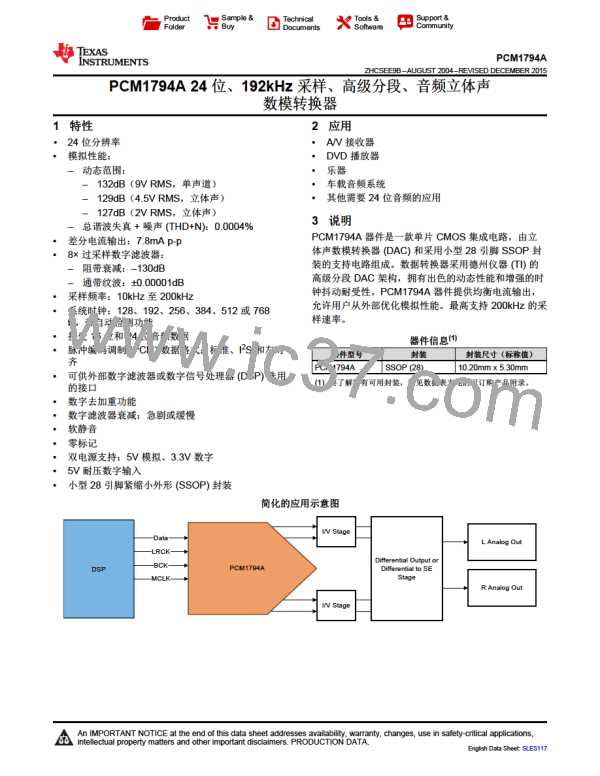PCM1794A
ZHCSEE9B –AUGUST 2004–REVISED DECEMBER 2015
www.ti.com.cn
7.3.4 Audio Data Format
Audio format is selected using FMT0 (pin 11) and FMT1 (pin 12). The PCM1794A device also supports monaural
mode and DF bypass mode using MONO (pin 1) and CHSL (pin 2). The PCM1794A device can select the DF
rolloff characteristics.
Table 3. Audio Data Format Select
MONO
CHSL
FMT1
GMT0
FORMAT
I2S
STEREO/MONO
Stereo
DF ROLLOFF
Sharp
Sharp
Sharp
Sharp
Slow
0
0
0
0
0
0
0
0
1
1
1
1
1
1
1
1
0
0
0
0
1
1
1
1
0
0
0
0
1
1
1
1
0
0
1
1
0
0
1
1
0
0
1
1
0
0
1
1
0
1
0
1
0
1
0
1
0
1
0
1
0
1
0
1
Left-justified format
Standard, 16-bit
Standard, 24-bit
I2S
Stereo
Stereo
Stereo
Stereo
Left-justified format
Standard, 16-bit
Digital filter bypass
I2S
Stereo
Slow
Stereo
Slow
Mono
—
Mono, L-channel
Mono, L-channel
Mono, L-channel
Mono, L-channel
Mono, R-channel
Mono, R-channel
Mono, R-channel
Mono, R-channel
Sharp
Sharp
Sharp
Sharp
Sharp
Sharp
Sharp
Sharp
Left-justified format
Standard, 16-bit
Standard, 24-bit
I2S
Left-justified format
Standard, 16-bit
Standard, 24-bit
7.3.5 Soft Mute
The PCM1794A device supports mute operation. When MUTE (pin 10) is set to HIGH, both analog outputs
transition to the bipolar zero level in –0.5-dB steps with a transition speed of 1/fS per step. The mute operation
system provides pop-free muting of the DAC output.
7.3.6 De-Emphasis
The PCM1794A device has a de-emphasis filter for the sampling frequency of 44.1 kHz. The de-emphasis filter is
controlled using DEM (pin 3).
7.3.7 Zero Detect
When the PCM1794A device detects that the audio input data in the L-channel and the R-channel is
continuously zero for 1024 LRCKs in the PCM mode, or that the audio input data is continuously zero for 1024
WDCKs in the external filter mode, the PCM1794A device sets ZERO (pin 13) to HIGH.
7.3.8 Advanced Segment DAC
Upper
0–62
6 Bits
Level
ICOB
Decoder
0–66
Current
Segment
DAC
Advanced
DWA
Digital Input
Analog Output
24 Bits
rd
3
-Order
5-Level
Sigma-Delta
8 f
S
0–4
MSB
and
Lower 18 Bits
Level
Figure 23. Advanced Segment DAC
16
Copyright © 2004–2015, Texas Instruments Incorporated

 TI [ TEXAS INSTRUMENTS ]
TI [ TEXAS INSTRUMENTS ]